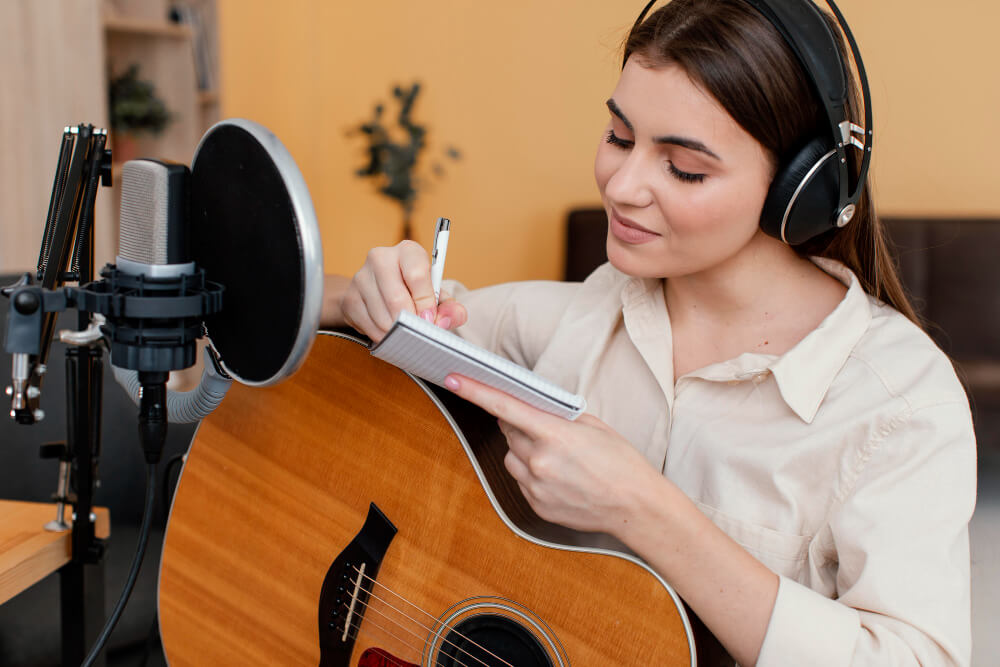We all love the sound of a band (who doesn’t really? Anyone? Bueller?). But when you’re asked to play in coffee houses, intimate spaces, restaurants, open mics, and other places where anything beyond a singer and an acoustic guitar would be overkill, that band sound isn’t there.
However, acoustic guitar players can approximate that full band sound if they apply a few simple tricks and concepts, making parts more full and more interesting to the listener (and, in turn, make it more fun for us to play!)
For this article, we will be looking at how to get a more “full-band” sound on the song “Listen to her Heart” by Tom Petty and the Heartbreakers, and assume that there will be a singer.
Let’s talk about chords
The first step is using as full-sounding chords as we can. The original song is in A major, however, I don’t find the A major open-position chord to sound as full as, say, an open-position G chord. So, listen to the difference between these two A major chords. One is voiced the traditional way, and one is voiced using a G major voicing with a capo on the second fret:
Here is where that G major voicing really shines. We still retain the lowest A note, however, the G voicing is a bit more full and has a wider range, something that we want in order to have that full sound. There are also some practical applications with some parts that make the G voicing better, but we’ll get to that later.
Getting percussive
Part of the fun of playing with a full band is having a great drummer behind you. So let’s try to approximate that.
Fingerstyle guitar players have long incorporated percussive sounds in their playing, so we can definitely take a cue from that. What we want to try to emphasize in this take on the song are the downbeats (beats two and four). This can be accomplished in one of two ways. One is by using accents where one chord is hit louder than the others, making it pop out. You can even make it more dramatic by really making a dynamic difference between the regular and accented hits:
The other way would be by simply giving the strings a quick, choked strum with the pick on those beats while emphasizing the chords:
Signature licks
The next part will be incorporating some signature licks into our guitar part. For “Listen to Hear Heart”, there are two that come to mind. One is the signature riff found at the beginning of the song. The other is the lower riff that occurs every other bar once the band kicks in. We want to incorporate as many of those signature elements as we can, without losing the body and groove that we want to keep in our arrangement.
Let’s start with the lower riff. This is where using a capo to voice a G chord comes in handy since all the notes will fall easily under the fingers:
Now when we incorporate that into our accented rhythms, we have a strong part that we can use for instrumental sections:
We can also apply it to parts where we’re striking the strings to get that percussive, snare-like attack. Just keep that lower note going with the more percussive stuff by lightly muting strings with your left-hand fingers:
Here, you will notice that we’re chocking more strings than usual, which is fine. Because the part is ultimately quieter, as long as the lower riff and the string come through, the sound should be full enough for our intentions.
Now let’s move on to the main riff. We want to try to best to incorporate these licks and riffs into our rhythm playing as much as we can. Again, we want that full-band effect, so keeping things as simple as possible is the best solution.
The riff’s notes extend between the root and the 3rd of the scale. Fortunately, we can play this facsimile of the riff on the open G string rather easily:
Because the open string is part of the G voicing, we can certainly play it while strumming the chord by getting fancy with our fingerings. You will notice that we need to sacrifice the highest note of the chord, as well as one of the lower notes of the chord to free up some fingers. However we still have enough body and range in the chord to sound full, not to mention the extra movement from the riff. For this, you will be holding the chord using your middle finger on the 6th string, and your 3rd finger on the second string, while your first finger handles notes on the second fret of the G string, and your pinky on the fourth fret notes.
As an added bonus, we’ll also add the lower riff on bar 4:
And with that, we have quite a few elements in place to play and sing the tune with just an acoustic guitar, while maintaining a big sound and keeping key elements in place. Let’s put it all together and arrange the intro, first verse and first chorus:
These tricks can be applied to several different songs. Use your ears and your imagination, and you’ll be able to create something full and groovy!

